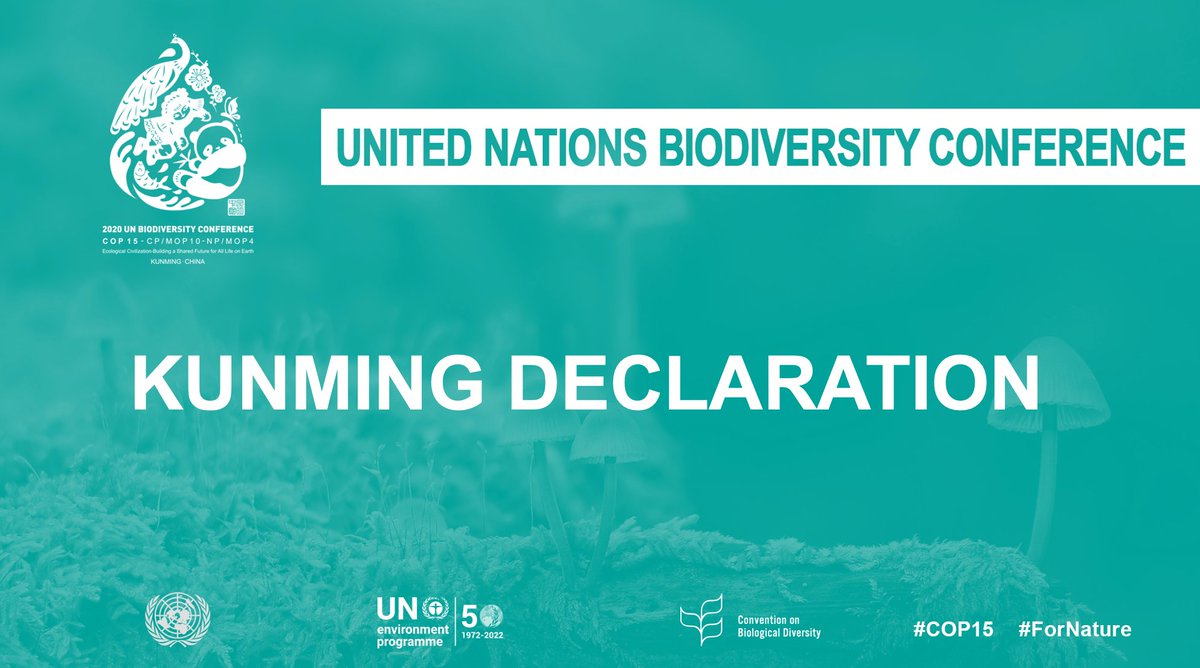Context
-
Recently, the Kunming Declaration on Biodiversity Conservation was adopted by over 100 countries at the first part of the ongoing 15th meeting of the Conference of the Parties (COP15) to the United Nations Convention on Biological Diversity (CBD).
About Kunming Declaration on Biodiversity Conservation
- The declaration demonstrates global commitment to an ambitious and transformative “post-2020 global biodiversity framework”, which will provide a strategic vision and a global roadmap for the conservation, protection, restoration, and sustainable management of biodiversity and ecosystems for the next decade.

- Under the theme of “Ecological Civilization: Building a Shared Future for All Life on Earth”, the Kunming Declaration addresses key elements needed for a successful post-2020 framework: the mainstreaming of biodiversity across all decision-making; phasing out and redirection of harmful subsidies; enhancing the rule of law; and increasing financial, technological, and capacity-building support to developing countries, among others.
What are the commitments under the Kunming Declaration?
- The Kunming Declaration outlines general targets for the restoration and protection of biodiversity. The document lists 17 commitments for member countries, urging both international collaboration on a number of issues and increased efforts at a domestic level.
- Below are some of the commitments outlined in the document.
- Developing and implementing a global biodiversity framework to reverse the course of biodiversity degradation and be on a “path of recovery” by 2030.
- Develop and implement an “Implementation Plan and Capacity Building Action Plan for the Cartagena Protocol on Biosafety” – an international agreement signed in 2003 that aims to protect biodiversity from the risks posed by biotechnology, such as genetically modified organisms (GMO).
- Adopting the ecosystem approach to increase resilience and help humans adapt to the adverse effects of biodiversity loss and climate change.
- Reduce negative effects of human activity on marine and coastal biodiversity.
- Integrate conservation and biodiversity into government decision-making for matters, such as poverty alleviation, economic policies, regulations, and other government policies.
- Increase coverage of area-based conservation and management to protect species and genetic diversity.
- Enhance both international and national environmental laws and strengthen enforcement of laws.
- Strengthen measures for developing and regulating biotechnology to ensure equitable distribution of its benefits while minimizing their environmental impact.
- Reform, eliminate, or phase out financial incentives that are harmful to biodiversity.
- Provide financial tools to developing countries to help them fulfil the commitments of the Convention.
- Enable participation of indigenous and local communities, as well as all relevant stakeholders, in the development and implementation of a biodiversity framework.
- Develop educational tools to improve communication and public awareness.
How effective is the Kunming Declaration expected to be?
- The Kunming Declaration does not hold members to any tangible or measurable biodiversity targets, leading some to cast doubt over how effective the document will be in inspiring real action.
- Many of the commitments outlined in the Kunming Declaration are basically a continuation of the 2011-2020 Strategic Plan for Biodiversity and the Aichi Biodiversity Targets, which also included commitments to reducing incentives for activities that threaten biodiversity, integration of biodiversity with other government policies, and increasing resilience against climate change.
- Meanwhile, in the Kunming Declaration – the “30 by 30” goal, is a proposed commitment to protect 30 percent of land by 2030. The declaration does not expressly commit to this goal, stating only: “Noting the call of many countries to protect and conserve 30 percent of land and sea areas through well-connected systems of protected areas and other effective area-based conservation measures by 2030”.
- The Aichi Biodiversity Targets, by contrast, committed to the conservation of 17 percent of terrestrial land and inland water and 10 percent of coastal and marine areas.
Back to Basics
About United Nations Convention on Biological Diversity:
- It is a multilateral treaty.
- The convention has three main goals: the conservation of biological diversity; the sustainable use of its components; and the fair and equitable sharing of benefits arising from genetic resources.
- Signed by 150 government leaders at the 1992 Rio Earth Summit, the Convention on Biological Diversity is dedicated to promoting sustainable development.
- The 15th COP of the UN Biodiversity Conference began on October 11, 2021.
- It was originally scheduled to take place from 15-28 October 2020 in Kunming, China but was postponed several times due to the novel coronavirus disease (COVID-19) pandemic.
About Cartagena Protocol on Biosafety
- It is an international agreement which aims to ensure the safe handling, transport and use of living modified organisms (LMOs) resulting from modern biotechnology that may have adverse effects on biological diversity, taking also into account risks to human health.
- It was adopted on 29 January 2000 and entered into force on 11 September 2003.
Environment Current Affairs UPSC 2022 : Click Here
IAS Abhiyan is now on Telegram:
- Abhiyan Official Telegram Channel: Click Here to Join us
- For Mains Value Edition (Facts, Quotes, Best Practices, Case Studies): Click Here to Join us
